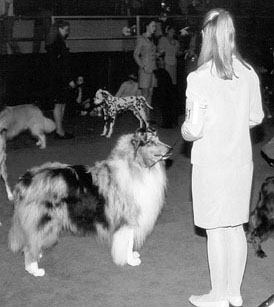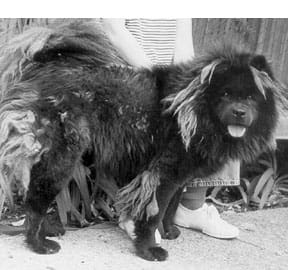Not long ago, the Miller five-dog pack consisted of two mixed-breed and three purebred dogs – a Scottish Terrier, a Pomeranian, and an Australian Kelpie. Of the purebreds, one was found as a stray, one was adopted from an animal shelter, and one was rehomed from a friend who could no longer keep her.
I get several calls every week from people asking me to refer them to a breeder. But it has been more than 20 years since we purchased a dog from a breeder, and I’d wager that I’ll go to my grave without ever purchasing another. Decades of work in animal protection made me painfully aware of the easy availability of any breed of dog your heart might desire.
The Top Five Caveats of Purebred Dog Buying
1. Research your desired breed carefully to avoid common breed problems. Each breed has certain defects entrenched in its gene pool.
2. Hold your breeder to an unreasonably high standard. Buying a puppy from a less-than-responsible breeder encourages that breeder to continue making contributions to the pet overpopulation problem. If you do buy from a breeder, be sure to buy from one who meets the description above as closely as possible.
3. Don’t fall into the “fad breed” trap. Learn about the breed that appeals to you – don’t get a Jack Russell because of Wishbone, a Border Collie because of “Babe,” or a Siberian Husky because you liked “Snow Dogs.” All three of those breeds can present above-average challenges to the novice dog owner.
4. Watch out for “breeder deals.” Unscrupulous breeders often try to unload their unsold adolescent pups who are now beyond the “cute” stage, or their “used up” breeding stock, with some story about how the dog was a show prospect who didn’t quite make it, and he’s willing to give you a really good deal. In fact, these dogs are often very poorly socialized, have had no training whatsoever, and are a real liability to the breeder, who should be paying you to take the dog off his hands. If anything the breeder tells you sounds “off,” it probably is. If you do take one of these breeder deals, be prepared to invest in the services of a good behavior consultant.
5. Avoid unreasonable expectations. Not every Collie can grow up to be a Lassie. If your German Shepherd pup’s ears never stand tall like they are supposed to, your Bichon Frise never makes it to Madison Square Garden, or your Australian Kelpie is afraid of cows, will you love her despite her flaws, and fulfill your commitment to love and keep her until death do you part?
The fact is, purebred dogs are everywhere. You can find them at shelters, in rescue groups, free in the newspaper, running loose in the streets, for sale by breeders, and, unfortunately, in pet stores. There are pros and cons to acquiring your next family member from any of these sources; you can find good dogs from any one of them, but each venue can also supply you with dogs with minor to severe health and behavior problems. Much of the dog breeding industry seems to subscribe to the “caveat emptor” philosophy. The average dog owner is very much on her own when it comes to acquiring a new canine companion, and she’d best be very wary, indeed. Let’s examine the good, the bad, and the ugly of each source of purebred dogs.

Ways to Find Specific Dog Breeds: Pros and Cons
Breeders
If you have any intention of showing your dog in conformation (or “breed” ring), she must have registration papers. If you want to be successful competing in the breed ring, you must have a very good quality dog with papers. There are good breeders who sell good quality dogs and bad breeders who sell unsound and unhealthy dogs. Both sell puppies with papers. Sadly, the irresponsible breeders abound, while the good ones are scarce.
After more than 30 years of experience working in and around animal shelters – and having seen untold thousands of mixed-breed and purebred dogs euthanized for lack of homes – I have developed a pretty stringent definition of a “responsible breeder.” In my opinion, an ethical breeder produces puppies solely for the purpose of improving the breed; her purpose is to attempt to come up with the best dogs she can, not to make money.
In a good breeding program, sire and dam are thoroughly screened for any health problems known to be common to that breed, and pairings are based on a complete awareness and understanding of how one dog’s qualities complement the other’s. Dogs of questionable temperament or health are never bred, and dogs of breeding quality are shown and titled in conformation and at least one competitive canine sport, to demonstrate that they have brains as well as beauty.
The conscientious breeder provides extra nutrition for the dam before and during pregnancy to ensure that she and the puppies are all healthy, and doesn’t hesitate to seek whatever veterinary care is recommended during gestation, whelping, and puppy development.
Once the puppies are born, they are kept in a clean environment and socialized to the extreme – beginning at about four weeks of age – in order to prevent any possibility of behavior problems related to the puppies’ unfamiliarity with other people and the world around them. Good breeders even begin training their pups before they place them in new homes – giving them a head start on good manners and helping them to be comfortable in crates and away from the pack even before they leave their littermates.
A conscientious breeder screens new homes carefully, and does not just sell puppies to the first buyer who arrives with check in hand. If, upon direct questioning, the buyer admits he is new to the breed, she educates him about all aspects of that type of dog, not just the warm-fuzzy qualities.
Good breeders just don’t sell puppies before the age of eight weeks, and have pet-quality pups spayed and neutered prior to placement (juvenile spay/neuter techniques now allow eight-week-old puppies to be safely sterilized – see “Spaying and Neuturing Information“. These breeders will be happy to give you a number of names and phone numbers of people who have bought her dogs; call these people and ask whether they are happy with their dogs’ health and temperament. Pay attention if they say they no longer have the dogs!
A good breeder might insist on visiting the buyer’s home to inspect the pup’s intended environment, and may refuse to sell a puppy to a home that doesn’t have a safely fenced yard. A good breeder rarely sells two pups to the same buyer, knowing full well what a difficult challenge it is to raise two baby dogs together without behavior complications. Good breeders also rarely advertise in the newspaper, since they have taken care to have prospective buyers for any pups they produce long before the breeding takes place, and they never sell to pet stores.
Finally, a responsible breeder makes a commitment to always take back any pups that she has produced at any time during that dog’s life, if the new owners must give them up for any reason whatsoever.
As you can see, there are relatively few breeders who meet my admittedly stringent criteria. If more breeders were of this type, there certainly wouldn’t be so many purebred and crossbred dogs available from other sources, such as shelters and rescues. A breeder who does anything less contributes actively to the serious problem of pet overpopulation in this country.
On the positive side, a truly good breeder is a treasure. She produces healthy puppies of exceptionally good quality, provides a valuable education to those fortunate enough to purchase from her, is a wonderful resource for her buyers once the puppies have gone home, and becomes a lifetime friend to her puppies and their new families.
Of course, breeders are not the only source for purebred dogs, and purebred dogs don’t have to be registered in order to compete in many canine sports. Many organizations offer competitions and titles for mixed-breed and unregistered purebred dogs – they are more interested in performance than pedigree. Even the American Kennel Club, the biggest stickler for “purebred-only” policies, will issue “Indefinite Listing Privileges” to dogs who appear to be purebred, even if registration papers are not available. A dog with an ILP number may enter all AKC-sanctioned competitions, such as obedience and agility, except for the breed ring, and an ILP dog can earn all AKC sports competition titles.
So, read on to learn more about additional sources for purebred dogs!
Animal Shelters
Most people are astonished to discover how many purebred and crossbred dogs and puppies end up in our nation’s animal shelters. Over the past three decades I have visited and worked in shelters around the country, and not once did I fail to find purebred dogs in the adoption kennels.
There are lots of good reasons to adopt shelter dogs. First, you may well save a life. At many shelters, adoption dogs have a limited time to find a home before overcrowding forces animal care staff to make euthanasia selections. You might also save money – many adoption fees include a complete package of vaccinations, license, ID tags, and spay/neuter that cost far less than the price of the actual services from a private veterinarian – not to mention the initial cost of a puppy from a private source.
While some dogs end up in shelters because of behavior problems, most do not. Some have minor, easily addressed behaviors or health issues that the previous owner couldn’t be bothered to fix, while many have no problems at all – they may simply have wandered off and their owners didn’t care enough to come look or pay impound fees. Still other “perfect” pooches get left at shelters because their owners are going through lifestyle changes that don’t include Fido.
You do need to be careful when adopting from a shelter. If your local shelter has a deserved reputation for harboring distemper and parvovirus germs, you will want to range farther afield and adopt from one with a good disease control program. Also, some shelters also do a better job than others at screening their canine adoption candidates and matching them to appropriate homes. You may need the help of your favorite dog trainer to find the shelter diamonds in the rough.
The best shelters offer breed match-up services. You can go in and get approved as a prospective adopter and be put in their files for a particular breed. When a dog of your chosen breed comes in looking for a home, they can call you to come see it. It may take a little patience to wait for the right dog to come along, but it’s well worth the satisfaction of knowing you have given a shelter dog a second chance at life.
Breed Rescues
In the last couple of decades, animal rescue groups have gained high visibility for their work. Today, there is a rescue group for every breed imaginable as well as for crossbreeds and mixed-breeds, and there are rescue groups in every community. Rescue dogs come from a variety of sources, including shelters, breeders, private homes, Greyhound racetracks, and law enforcement actions against puppy mills and hoarders (animal collectors).

Like shelters and breeders, rescue groups may also range from very good to very bad. Good rescue groups offer dogs who are fully vetted, already spayed and neutered, and evaluated for behavior problems. They fully disclose any known or anticipated behavior challenges, and screen prospective adopters. A good rescuer is an expert in her breed, and will make sure you are prepared to manage the idiosyncrasies of your chosen breed.
Beware of rescuers who develop a hoarder syndrome. Animal lovers who do rescue work are sometimes unable to recognize when their responsibilities have come to outweigh their resources. Steeped in their mission to save lives, they may end up rescuing more animals than they can care for, or take animals who require far more rehabilitation than they, or the average adopter, can provide.
Be prepared to pay an adoption fee for your rescued dog. Good rescue groups make a significant commitment of resources to rehabilitate and place their wards. They are largely dependent on donations, and your adoption fees will help defray some of their operating and animal care expenses.
Newspaper Ads
Good breeders do not advertise in local newspapers; they don’t have to. Backyard breeders and puppy mills do frequently advertise there, and are not a recommended source for your new family member.
You can, however, find your ideal dog in the paper if you are careful, and if you can resist the temptation to fall for the first furry face you see. Look for a private owner who must place an individual dog for some reason – usually a lifestyle change, or a sober realization that the addition of a dog to the family was an unfortunate mistake. Be sure to take the time to evaluate the dog thoroughly before you take him home, and have a clear understanding with the owner about your ability to return him should he not work out for you.
Pet Stores
The only positive aspect of purchasing a puppy from a pet store is that you rescue that doggie in the window – that’s a good thing for that individual pup. However, while some people are perfectly happy with their pet store purchases, the risks related to buying pet store puppies so greatly outweigh the single good that we urge you to never even let the thought cross your mind.
For starters, when you purchase a pet store puppy, you support the horrendous puppy mill industry. Every dollar you spend to rescue that beguiling face in the window goes to produce, market, and sell more puppies who are raised in substandard conditions. By “freeing up” that puppy’s cage, in essence, you place the pet store owner’s order for more puppies, to be produced by mothers who are nothing more than breeding machines to the puppy farmer. Pay no attention to the store manager’s reassurances that their puppies come from “responsible breeders.” No responsible breeder sells puppies to pet stores. None.
Every breed of dog is burdened with the potential for specific diseases or medical conditions; when genes pass along traits for a specific coat type and color, conformation, and temperament, they also transmit the parent’s potential for hip dysplasia, heart defects, cancer, etc. The parents of pet store puppies are unlikely to have had any screening for the genetic defects – they may, in fact, be castoffs who actually suffer from the inherited conditions – so the chances are far greater that your pup will suffer from one or more of these debilitating defects in his lifetime. The puppies and their parents may have missed out on some important health care practices, such as good basic nutrition and deworming.
The sooner people stop buying pet store puppies, the sooner pet stores will stop selling them, and the sooner puppy mills and other irresponsible breeders will start going out of business.
Finders Keepers
Of course, you could always buy into the “No two alike” philosophy of dog-keeping. With this guide, and no preconceived idea of who we want our next dog to be, we are always open to our next serendipitous canine discovery. If we had our hearts set on a particular breed, we would have missed the opportunity to keep Dubhy, the piano-playing, skateboard-riding Scottish Terrier who wandered into our family last winter and has amused us with his no-fear attitude and Gaelic sense of humor ever since. Nor would we have had the joy of sharing our lives with Josie, the Terrier mix who crossed our paths 15 years ago during a cockfighting investigation, and who has been my teacher and guide on our positive training path ever since.
Get the Right Dog for the Job
There are 150 breeds of dogs eligible for registration with the American Kennel Club (AKC), the best-known breed registry in this country, and hundreds more recognized by other registries. When planning for your next four-footed family member, consider what purposes the dogs have been bred for, as well as the environment you can provide for him.
The AKC assigns their recognized breeds into seven groups, based on the uses for which the breeds were originally developed. They also have a Miscellaneous Class for breeds still under consideration for recognition. Other than Miscellaneous, however, the group that your desired breed falls into can tell you a lot about his likely characteristics.
SPORTING GROUP
These are the “bird dogs” – setters, spaniels, pointers, and retrievers – commonly used by hunters to seek out and retrieve “game” birds such as ducks, geese, pheasant, grouse, etc. They tend to be alert, have a lot of energy, show an affinity for birds, and be exceptionally oral – the retrievers especially. They need lots of exercise, and are bred to work very closely with humans, so tend to be pretty attentive to people.
HOUND GROUP
These are hunting dogs who either use their noses (scent hounds) or their eyes (sight hounds) to follow their prey. Both classes of hound are bred to take off after prey without worrying about where their humans are; their natural tendency is to be more environmentally-focused than human-focused. They are perfectly trainable, but the handler must work harder to convince the hounds that it is worth their while to play the training game. The scent hounds (Beagles, Foxhounds, etc.) tend to be very vocal, as they are bred to “sound off” when tracking prey.
WORKING GROUP
These dogs have been bred to perform such duties as guarding, pulling carts and sleds, and water rescue. The Mastiff is in this group, as are the sheep-guarding breeds, Rottweiler, Newfoundland, Husky, and several others. They are generally large, with a protective and somewhat independent nature, so we ought not be surprised that they can find themselves in grave trouble when neglected. Many of them (sled dogs excepted) tend to more placid than lots of other breeds. Despite its size, a Bernese Mountain Dog, for example, may be a better choice for apartment living than the diminutive but energetic and often vocal Jack Russell Terrier.
TERRIER GROUP
These feisty, energetic dogs range in size from fairly small, as in the Norfolk or Cairn Terrier, to the large Airedale Terrier. Because their ancestors were bred to hunt and kill vermin, terriers typically have little tolerance for other animals, sometimes includ
ing other dogs. They tend to be known as the group with an “attitude,” and are quite likely to take offense if you try to force them into compliance with your wishes.
TOY GROUP
These little guys are born with genetically enhanced lap instincts. If well-trained and socialized, these wonderful canines can make great companions, as well as therapy and service dogs. If not, they can be little terrors. Because of their tiny size, they are generally easy to control, so many owners do tend to skip training and overlook bad manners. Unfortunately, this has given some toy dogs a reputation for jumping up, “yapping,” and other annoying but easily prevented habits.
NON-SPORTING GROUP
This is AKC’s diverse group of dogs who don’t fit into any other category. There is no consistency here – they range from the Bichon Frise to the Chow-Chow. You will need to do more indepth research to determine if one of the Non-Sporting dogs is right for you.
HERDING GROUP
As the name implies, these dogs were bred to herd livestock on behalf of their slower human handlers. It stands to reason, then, that they have an above-average attraction to things that move (and a related, sometimes uncontrollable desire to nip aforesaid moving things). They also tend to be vocal, and possess high energy levels. Like the Sporting breeds, they do have an inbred tendency to work well with humans – it is no accident that Border Collies, Shetland Sheepdogs, and Australian Shepherds are top scorers in competitive obedience and agility. Their strong herding instincts, however, may make them ill-suited to live with children unless well-supervised; their natural desire to chase and nip can get them into trouble.
These brief cameos of the various breed groups don’t even begin to scratch the surface. If you are in the market for a new dog, give serious thought to who you want her to be – don’t fall for the first furry face you see. Then, research the breed thoroughly to be sure you’re prepared to accept the inherent behavioral tendencies that are likely to come with her.
If it’s too late for you to do pre-purchase research, at least read more about the dog who already shares your home, so that you understand better why he does what he does, rather than getting angry at him for being who he is. Understanding is the first step toward modifying unwanted behavior – anger just gets in the way of training.
Finally, remember that just because a breed has certain tendencies doesn’t mean that all members of the breed act that way. If your heart is set on a highenergy Border Collie who will win herding trials and agility titles, remember that some Border Collies are calm and some aren’t the least bit interested in sheep. Spend enough time observing the potential candidates to make sure you get a high-energy sheep-magnet.
A Word About “Registration Papers”
There are a number of organizations that register various breeds of dogs. The American Kennel Club and United Kennel Club are the most widely recognized and respected in this country, but even AKC and UKC registration papers are no guarantee of quality, or of mental or physical soundness. In fact, among unscrupulous individuals in the industry, paper-swapping and falsification is a not-uncommon practice. Say a litter of three Jack Russell Terrier puppies is born. An unscrupulous breeder can register a litter of five, and then have two extra sets of papers to apply to any spare Jack Russells who happen to come along.
Pedigrees can be even more confusing. A pedigree is a dog’s “family tree,” and tells a knowledgeable dog person a great deal about a dog’s breeding. Backyard breeders will point triumphantly to champions listed in red ink several generations back in a puppy’s pedigree and advertise puppies from “champion lines.” The average puppy buyer doesn’t realize that the absence of red ink in the most recent two or three generations of the pedigree speaks volumes about the lack of attention to quality in the current breeding program.
Pat Miller is WDJ’s Training Editor and the author of The Power of Positive Dog Training.






